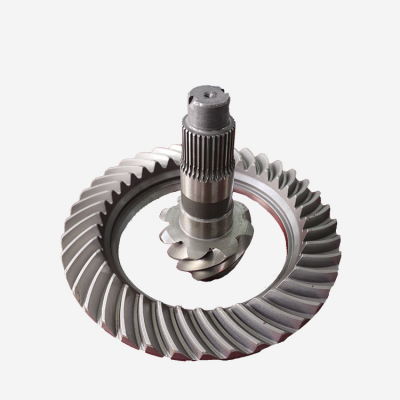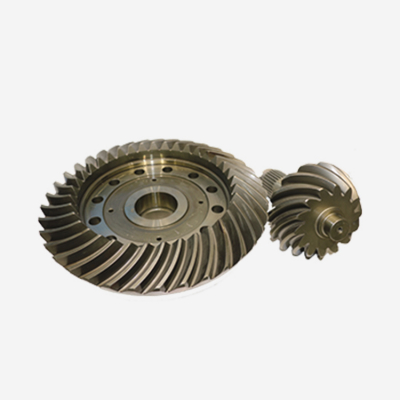Four types of common faults and solutions for automobile drive shafts
Automobile transmission shaft is mainly composed of shaft tube, telescopic sleeve and universal joint. Among them, the telescopic sleeve can automatically adjust the change of the distance between the gearbox and the drive axle. The universal joint is to ensure the angle change between the output shaft of the gearbox and the input shaft of the drive axle, so as to realize the constant angular speed transmission of the two shafts. The general car universal joint is a cross shaft universal joint, as the name suggests, it is composed of a cross shaft, a cross bearing, and a flange fork. The transmission shaft expansion sleeve of the traditional structure is that the spline sleeve and the flange fork are welded together, and the spline shaft is welded on the transmission shaft tube. The transmission shaft is added with a tubular sealing protective sleeve on the outside, and two lubricating fat bags are set at the end of the protective sleeve.
First, the swing of the transmission shaft causes the whole vehicle to shake.
During the driving process of the whole vehicle, if you can hear very obvious periodic noise or vibration from the chassis, the sound will become stronger as the vehicle speed increases, and in severe cases, it will be accompanied by body shaking, and the hand holding the steering wheel will feel numb. However, when the vehicle was stopped and the engine was running at various speeds, it was found that the vibration noise suddenly disappeared.
Generally, it can be preliminarily judged that the transmission shaft is bent or twisted and unbalanced. The main reason is that the shaft tube of the transmission shaft is bent, and the rotation imbalance increases after the shaft tube is bent, and the centrifugal force increases during rotation, causing periodic vibration and abnormal noise.
When we design the drive shaft, the critical speed of the drive shaft will be designed higher. However, due to the dynamic balance damage and universal joint damage caused by the bending of the drive shaft, the critical speed of the drive shaft will be reduced. This can easily cause the transmission shaft to resonate with the entire vehicle, with large amplitude and severe vibration, and in severe cases, the transmission shaft often breaks.
The second is the abnormal sound of the drive shaft loosening
During the driving process, especially when starting or accelerating quickly, the truck makes a "cracking" impact sound, which obviously shows a feeling of looseness. If we exclude the looseness of the basin angle gear or cylindrical gear in the drive axle, it should obviously be that the transmission shaft is loose.
The loose parts are nothing more than the universal joint cross shaft bearing, the spline shaft and the spline sleeve of the telescopic sleeve. Generally speaking, the looseness of the shaft diameter of the cross shaft and the bearing should not exceed 0. .13mm, the wear of the meshing gap between the telescopic spline shaft and the spline sleeve should not be greater than 0.3mm, if the use exceeds the above, the transmission shaft should be replaced.
Third, loosen and fall off the connecting bolts.
During the normal driving of the car, if the drive shaft bolts loosen or fall off during the running of the car, it may cause mechanical accidents and even cause great harm. There are many reasons for a drive shaft bolt to come loose. Only by accurately finding out the main reason for the looseness of the drive shaft can we cure the symptoms and prevent accidents.
The main reasons include: the plane of the tooth flange on the end face connecting the universal joint with the transmission or drive axle is uneven. Due to the unevenness of the flange plane, the two flanges become point contact due to surface contact, and the static friction force between the flanges is greatly reduced. Or because the bearings of the universal joint are loosely worn and the ten points are severely worn, the vibration of the transmission shaft is increased when rotating.
Moreover, the drive shaft is bent, and the dynamic balance imbalance causes the drive shaft to vibrate during operation, and the drive shaft bolts are loosened due to the jitter. Or when tightening the drive shaft bolts, the bolt tightening force is insufficient, and unqualified bolts of poor quality are used.
When re-maintenance, it is also necessary to pay attention to the dynamic balance of the transmission shaft should not be too large, the accuracy of the transmission shaft must meet the requirements of use, to avoid the two flange shafts are not easy to overlap during installation, or the centerline of the universal joint cross shaft at both ends of the transmission shaft is not cannot rotate at a constant speed on the same plane. Otherwise, it will cause the failure to recur and cannot cure the symptoms.
Fourth, the drive shaft universal joint cross shaft is worn
The failure of the drive shaft universal joint is mainly due to the wear of the journal and bearings and the bending deformation of the four journals of the cross shaft, resulting in that the centerlines of the cross shafts are not on the same plane, or the centerlines of two adjacent shafts are not perpendicular.
Due to the excessive wear gap between the cross shaft neck of the universal joint and the bearing, the cross shaft shakes during operation, causing the center line of the transmission shaft to deviate from its rotation center line, causing the transmission shaft to vibrate during operation and the transmission shaft There is an unusual noise.
From the point of view of use, the wear of the cross journal of the universal joint and the bearing should not exceed 0. .02~0.13mm, generally kept around 0.01mm. If it exceeds 0.13mm, the transmission shaft will vibrate and make noise.
When the vehicle is running, since the direction of torque transmission is consistent, the force direction of the cross shaft is also consistent. Over time, one side of the cross shaft neck wears abnormally; over time, the stressed side of the cross shaft wears up and grooves, causing looseness and noise. For the problem of unilateral wear, it is recommended to rotate the cross shaft 90 degrees compared with the original position, which can prolong the service time



